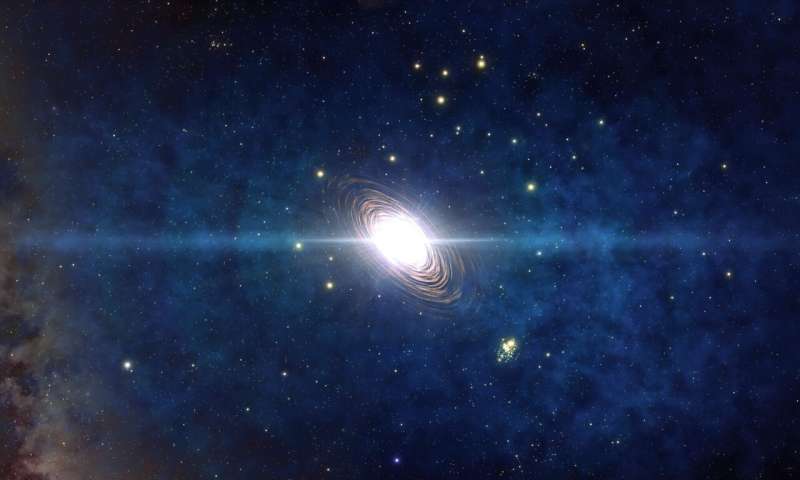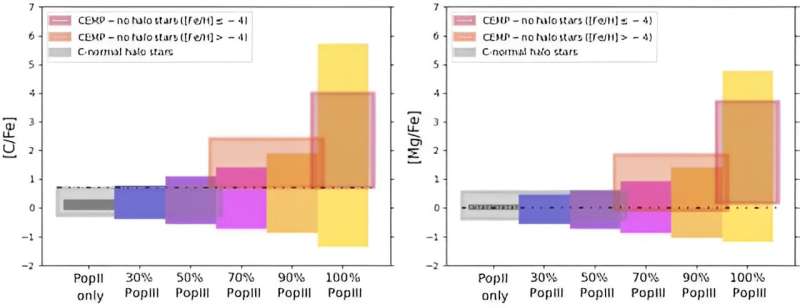This article has been reviewed according to Science X's editorial process and policies. Editors have highlighted the following attributes while ensuring the content's credibility:
fact-checked
preprint
trusted source
proofread
We can't see the first stars yet, but we can see their direct descendants

If you take a universe worth of hydrogen and helium, and let it stew for about 13 billion years, you get us. We are the descendants of the primeval elements. We are the cast-off dust of the first stars, and many generations of stars after that. So our search for the first stars of the cosmos is a search for our own history. While we haven't captured the light of those first stars, some of their direct children may be in our own galaxy.
The first stars were massive. Without any heavier elements to weigh them down, they needed to be about 300 times that of our sun in order to trigger nuclear fusion in their core. Because of their size, they went through their fusion cycles rather quickly and lived very short lives.
But the supernova explosions signaling their deaths scattered heavier elements such as carbon and iron from which new stars formed. Large second-generation stars also died as supernovae and scattered even more heavy elements. As a result, each generation of stars contained more and more of these elements. In astronomy lingo, we say each generation has a higher metallicity.
Of course, which generation a star is in can be fuzzy. Clearly, the very first stars, forming entirely out of primordial hydrogen and helium are first-generation stars, and stars forming entirely out of the remnants of the first generations are true second-generation stars. But stars form at all different sizes, so it's quite likely that some massive second-generation stars became supernova before some of the smaller first-generation stars.
Many early stars could have formed from mostly first-generation material with a touch of second-generation dust, while others formed mostly from second-generation stars with a sprinkling of first-generation heritage. Stars like our sun are likely a mix of material from multiple generations.
![The distribution of stars in our galaxy. Credit: NASA, ESA, and A. Feild [STScI] We can't see the first stars yet, but we can see their direct descendants](https://scx1.b-cdn.net/csz/news/800a/2023/we-cant-see-the-first-1.jpg)
For modern stars, rather than trying to determine their generation, we categorize them into populations based on their metallicity. A star's metallicity is taken as the ratio of iron to helium [Fe/He] on a logarithmic scale. Population I stars have an [Fe/He] of at least -1, meaning they have 10% of the sun's iron ratio or more. Population II stars have an [Fe/He] of less than -1. The third category, Population III, is reserved for true first-generation stars.
In the Milky Way galaxy, most of the stars in the galactic plane are population I stars like the sun. They formed much later in the history of our galaxy, and are younger with more metals. Older population II stars are generally found in the halo surrounding our galaxy, or in the old globular clusters that orbit the Milky Way. That makes sense since older stars have had more time to drift out of the galactic plane. Given the evolution of our galaxy, it's quite likely that some of the population II stars in our halo are truly second-generation stars. But how can we distinguish them from other old stars?
That's the goal of a new study published on the arXiv preprint server. It looks at both observations of distant quasars and simulations of population III stars to determine the metallicity of truly second-generation stars. The authors found that while second-generation stars would be rare in the Milky Way halo, some could be lurking there. The key to identifying them is not their abundance of iron relative to helium, [Fe/He], but rather the ratios of carbon and magnesium to iron, [C/Fe] and [Mg/Fe].

Carbon is formed in stars as part of the CNO cycle, which is the second-level fusion cycle after hydrogen burning. Magnesium is a product of a 3-stage fusion of carbon with helium. Many first-generation stars exploded as high-powered supernovae, but some exploded with lower energy. These low-energy supernovae would cast off elements such as carbon and magnesium, but not much iron. So, stars with an exceptionally high [C/Fe] ratio likely formed from the remnant material of a single first-generation star. The lower the [C/Fe] ratio, the more likely a population II star formed from first and second-generation stars.
So it seems the key is to look for halo stars with [C/Fe] > 2.5. We haven't found any such stars yet, but as more sky surveys come online it is likely only a matter of time. We will still have to search the most distant galaxies to find a first-generation star, but we may soon find one of their children much closer to home.
More information: Irene Vanni et al, Characterising the true descendants of the first stars, arXiv (2023). DOI: 10.48550/arxiv.2309.07958
Journal information: arXiv
Provided by Universe Today





















